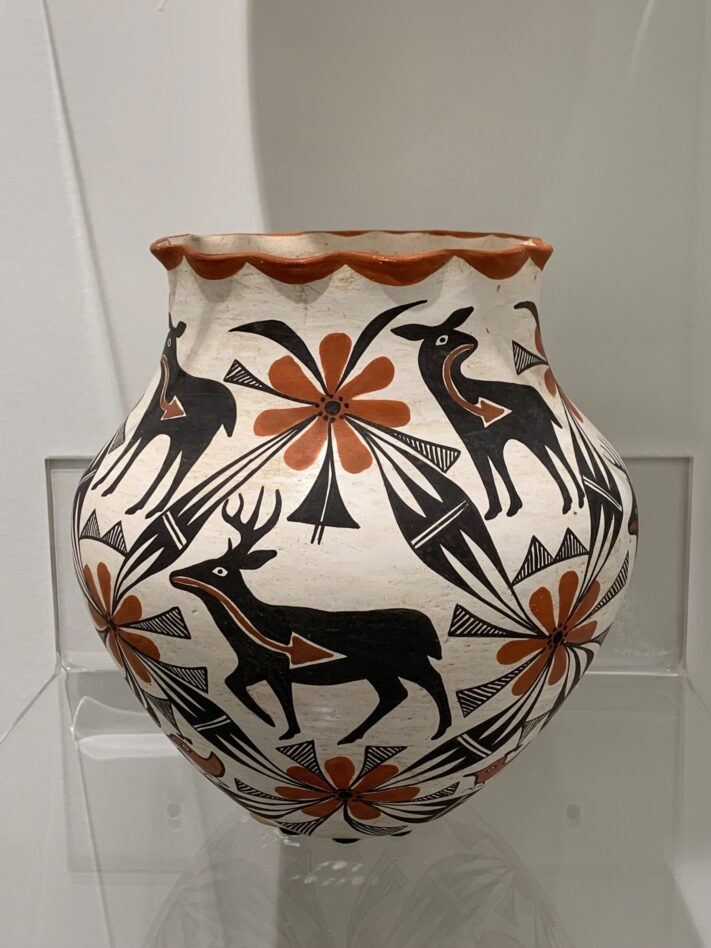
Attributed to Mildred Antonio, 1950s, Acoma Pueblo Pottery, The Hilbert Collection
North Building
Spirits of Earth and Fire: Pueblo Pottery from The Hilbert Collection
June 14, 2025 – February 15, 2026
Curated by Mary Platt
The history of Indigenous American Pueblo pottery stretches back over a thousand years, rooted in the enduring traditions of the Ancestral Puebloans—sometimes referred to as the Anasazi—who lived across the Southwest in what is now New Mexico, Arizona, Colorado and Utah. These early potters developed sophisticated techniques for shaping and firing clay vessels using hand-coiling methods, without the use of a potter’s wheel. While many early pieces served utilitarian purposes such as storing food and water, they often featured complex painted designs and surface treatments that carried spiritual and cultural significance.
Over time, the distinct pueblos—such as Hopi, Zuni, Acoma and Santa Clara—each developed their own characteristic styles, materials and decorative motifs. Acoma pottery is renowned for its eggshell-thin walls and bold geometric designs, while Santa Clara and San Ildefonso potters are famed for their polished blackware, created using a traditional reduction firing process that turns red clay a lustrous black. Hopi pottery frequently features symbolic imagery drawn from nature and the spirit world, including stylized birds, rainclouds and fertility symbols. Each community’s pottery tradition is a reflection of deep-rooted cultural values and teachings, passed down through generations, often within families of highly skilled women potters.
In the late 19th and early 20th centuries, as railroads and highways brought more visitors to the Southwest, a new market for Pueblo pottery emerged. Entrepreneurs and hoteliers—most notably Fred Harvey—recognized the appeal of Native American culture and crafts to tourists from the East Coast and Europe. Programs such as the Indian Detours, run by the Harvey Company, whisked affluent travelers by luxury automobile from hotels to remote pueblos, where they could observe dances, visit artists and purchase handmade goods directly from the source. Pueblo pottery, once primarily made for domestic and ceremonial use, was now also being shaped for sale, leading to new hybrid forms that balanced tradition with market demand. Artists maintained traditional techniques while adapting some designs and scales to suit tourist tastes, leading to a flourishing of creativity and wider recognition.
Today, many Pueblo families have carried on these traditions, blending innovation with cultural continuity. Modern Pueblo pottery remains both a sacred cultural practice and a thriving art form, celebrated for its beauty, craftsmanship, and enduring connection to the land and people of the Southwest.
This exhibition showcases works collected over many years by Mark Hilbert. It highlights the artistry of top Indigenous potters from the pueblos of the Southwest, including exquisite tiles by the legendary Nampeyo and elegant vessels by Sara Fine Tafoya, Monica Silva, and others. Formed from the land and fired with care, these ceramics embody centuries-old traditions passed down through generations of Pueblo artists.
Tickets/Reservations
The Hilbert Museum recommends FREE online reservations for entry. Guests who arrive without a reservation will be assisted by our staff as available and admitted as space permits. We look forward to seeing you!